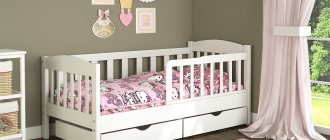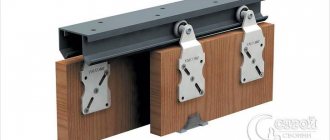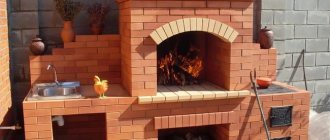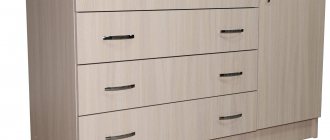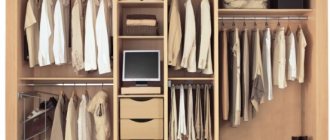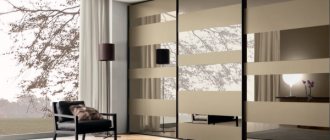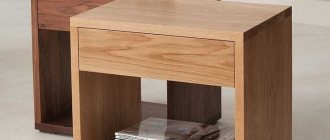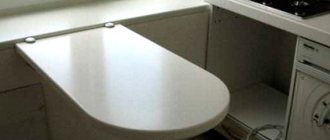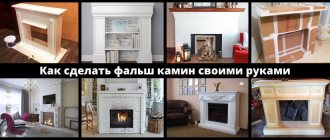Design
Hanging bed - an unusual design solution in the bedroom interior
Any bed, regardless of shape and configuration, consists of the following components:
- Frame
- Base
- Side and support panels
- Optional design elements (legs, hanging backrests, headboard, storage drawers, lifting mechanism)
A home-made sleeping place usually consists of a frame on which a base is installed - a mattress support. The supporting structure is made from:
- wooden slats (slats)
- metal mesh
- spring mechanism
Furniture for sleeping and relaxation can:
- have legs (most often no more than 20 cm high)
- be floor-standing (the frame is located directly on the floor)
- be suspended (fixed to the ceiling)
Original headboard for bed
The headboard is a decorative element that:
- carved from wood
- sawn from chipboard
- forged from metal
- upholstered with foam rubber and fabric
- can be carved and solid, straight and curved
In addition to the main functionality - a place to rest, the bed also serves as:
- closet
- stand
- sofa
- podium
In these cases, the mattress is hidden in the shell of the body during the day, and at night it is unfolded using a “book” mechanism or a gas lift.
Homemade bed from pallets
Modern youth with unconventional views on life know how to find beauty in the most unusual things. When working on the interior design of an apartment, the emphasis is on convenience and comfort at the lowest cost.
A bold solution in this case is to make your own bed base from old wooden pallets. To do this, you will need a minimum set of materials, tools, skills and facilities.
Four pallets should be placed close to each other on the floor and secured together with connecting strips. Two trays are installed vertically at the head of the bed and firmly attached to the wall. Now you should place the mattress and secure the restrictive beam around the perimeter. Cheap, cheap, simple and in step with fashion.
Choice of frame material
For self-assembly of furniture, wooden models are most often chosen
For the body of sleeping furniture, reliable materials with high strength values are used:
- Tree . Natural, eco-friendly material, best suited for work. However, it is afraid of moisture and is susceptible to fire
- Metal (corners or pipes). Such furniture will be durable, will last a long time and will not creak. It is worth considering the large weight of the structure and the risk of corrosion. In addition, the strict cold design of metal is not suitable for every interior.
- Fiberboard or chipboard. Furniture is the most fragile and therefore unreliable.
- Rattan _ Durable, versatile material, but expensive. It is cheaper to buy a ready-made rattan product
- Pallets . Making a structure from them is reminiscent of assembling a construction set from identical parts. But pallets do not always fit into the traditional conservative style of an apartment
Final processing of the product
After the installation of the bed frame is completed, you should begin finishing the surfaces. Start processing by sanding each part with sandpaper, with the coarsest-grained sandpaper, gradually moving to finer-grained sandpaper . Surfaces should be treated so that they are completely smooth to the touch.
After this, the sanded surfaces should be thoroughly wiped with a dry cloth to completely clean them of dust and dust. Do not use a damp cloth for this: due to exposure to moisture, the smoothness of the wood will disappear, and you will have to start sanding the surface again .
Now cover the entire bed frame with stain. Its color can be whatever you wish; there is a large selection of this material on the market. The saturation and depth of the final color will depend on the number of layers applied: the thicker, the darker.
After the stain has completely dried, varnish the surfaces.
The choice of glossy or matte varnish also depends on your own preferences. When finished, leave the varnished bed for a day to dry.
Bed dimensions
Drawing of a double bed
Depending on the parameters of the sleeping place, the beds are:
- Single . The optimal width for resting 1 person is 85–120 cm, length is no more than 2.2 m
- One and a half . Width – up to 1.6 m, minimum length – 1.9 m. Suitable for free sleep of 1 person or rest for a mother and a small child
- Double . From rectangular shapes - 1.6 m by 1.9 m to almost square - 2.3 m by 2.2 m. This design comfortably accommodates 2 people
Another option is bunk furniture, where 2 sleeping places are located one above the other on a metal frame. Most often they are used to equip children's rooms, where this is the only way to save space.
Drawing 160 by 200
Before you start making a bed, you should decide on its size. The ideal option for two adults would be a double model with dimensions of 160x200 cm.
This drawing should indicate all the main points for the manufacture of furniture:
- exact dimensions;
- assembly materials;
- fasteners.
At the stage of drawing up the drawing, it is important to determine not only the size of the bed, but also the height of the legs of the product. To do this, just imagine from what height it will be most convenient for you to get up.
Attention : too low products, although they are original, are impractical and completely inconvenient to use.
At the stage of creating the diagram, decide on the headboard and footboard . Consider whether you might want to make the product functional and equip it with drawers for linen or a lifting mechanism.
Preparatory work
Schematic drawing for assembly
Before deciding to assemble furniture yourself, experts advise determining the following parameters:
- Location of the structure in the room
- Number of people who will use it
- Availability of material for the manufacture of the frame and necessary accessories
- The ability to buy a ready-made mattress or the need to order a non-standard size option
- Availability of drawings and diagrams for manufacturing
Using an air mattress
Select the size you want to buy. Air mattresses, like regular mattresses, come in twin, full, queen, and queen sizes. It's probably better to split and get a full or queen.
Even if you only plan to sleep one person, a twin is still quite small and may not offer enough space to fit comfortably.
- When purchasing, it is best to give preference to a mattress that comes with a pump. Very often they come in one set along with the mattress.
- When it comes to an air mattress, more expensive does not always mean better. Much of the comfort will depend on how you set it up. Today, the price of a quality mattress ranges from $45 to $75.
Place the air mattress on a soft surface. Most air mattresses have vinyl or plastic underneath to keep them from moving.
This can create noise at night and may not always help keep the mattress in place. If possible, place the mattress on a carpet.
Use sleeping bags. Unpack your sleeping bag and place it on the mattress. It will serve as a pillow to make the bed softer. The bag will also help keep you warm, as the plastic on some air mattresses loses heat quickly. Cover it with the sheet provided to keep it in place.
Necessary materials
A level, tape measure and fasteners are needed to assemble any bed.
After selecting the frame material and calculating the dimensions of the future bed, purchase the necessary materials. For a wooden structure (fibreboard, chipboard, plywood, rattan) - this is glue, acrylic varnish, wood stain, painting brushes, sandpaper, putty.
To work with metal you will need the following tools:
- circular saw (grinder)
- metal drill set
- welding machine
- file
- brush for metal surfaces
Tools for making a bed
Any of these structures cannot be assembled without:
- measuring tape
- electric drill
- metal corners
- screwdriver
- self-tapping screws
- adjustable square
It is convenient to work with wood, having the following tool set:
- electric jigsaw (hacksaw)
- chisel
- plane
- Grinder
What you need for the mounting system
Most often, furniture screws are used as fasteners. This is the most reliable and durable method, but if such elements are not available, you can limit yourself to ordinary self-tapping screws. When using them, it is recommended to additionally strengthen the attachment points with metal corners.
Iron corners will be a good support for the bed.
The size of the fastener must be related to the width of the elements being fastened and be at least one and a half times the total width for each connection.
Furniture Assembly Instructions
Pallet bed
When making a bed from different materials, the tools used and the procedure are different. Let's look at each case in more detail.
Made of wood
Double wooden furniture, assembled on your own, will decorate any interior
A balanced choice for a beginner in carpentry is to make a rectangular structure from solid wood.
Calculation of materials
Wooden blocks and boards - the main materials for making a bed - must be dry and of high quality
To make a double wooden bed with legs measuring 1.6x2 m you will need:
- 15 pieces of pine beams 220 cm long and 5 by 5 cm in section
- 22–24 planed 2-meter boards, 10 cm wide, at least 2 cm thick
- Glue
- Self-tapping screws (0.4 cm and 0.6 cm)
- Metal corners of suitable size
Step by Step Actions
Ready to assemble bed frame parts
Next, the work is performed step by step according to the following instructions:
1 Using wood glue, glue together 4 wooden blocks with a length of 220 cm (2 parts), 160 cm (2 parts), 210 cm (1 part). The result is 5 blanks of different sizes, but the same thickness of 20 cm
2 Fold the paired blanks into a rectangle and fasten the joints with glue. Corners overlap for strength
The joints of the parts are reinforced with metal corners
3 A single crossbar is attached to an inverted frame along exactly the middle. The lamellas are subsequently attached to it. Strengthen the jumper with persistent 15-centimeter bars or metal corners
4 Additionally, the parts are fastened with self-tapping screws. At this stage, it is important to ensure that the proportions of the structure are maintained and the right angles inside
The legs are attached with self-tapping screws to the corners of the frame
5 The legs are screwed into the corners of the frame - they are the remains of the same pine beam with a length of 20–30 cm or higher (optional). Attach the supports to the inverted frame with glue, self-tapping screws, and reinforce them on both sides with corners
6 The block in the middle of the wooden blank is also placed on 2 legs on top and bottom to give the structure additional stability and prevent the center from sagging
The slats are laid perpendicular to the side and central panels
7 The body is turned over. Support boards or remnants of timber are installed at the same level as the central crossbar. Lamels are placed transversely on top of them at a distance of 4–5 cm from each other.
8 It is important that the boards laid crosswise do not rest against the sides of the frame - this will cause the structure to creak during use. Provide a gap of at least 0.5 cm on each side
9 The slats are screwed to the side and central panels with two 4 cm screws so that the base is rigid and can withstand the weight of the mattress and people
10 Check the correct installation, the stability of the frame, sand all wooden elements with a machine or sandpaper
Finished piece of furniture covered with stain
11 The finished product is coated with a primer or stain, and then varnish
12 From the remaining boards they knock down a headboard, which is attached not to the frame, but to the wall above the bed
How to make a double bed with your own hands using a tool
How to make a bed with your own hands: step-by-step instructions for assembling designer furniture | 60+ Photos & Videos
Made of metal
Scheme for welding metal profiles with a reinforced grid at the base
It is difficult for a beginner to make metal furniture without the skills of welding and cutting metal, however, with minimal experience, it is possible. Experts do not recommend assembling parts with bolts - the structure will quickly become loose.
When working on a bunk metal bed, profile pipes are used:
- 2 by 2 cm (from 40 m and more)
- 4 by 4 cm (minimum 8 m)
- 5 by 2.5 cm (8–10 m)
Bunk beds are best for children's rooms
When working, they start by making the backs from 4x4 cm pipes, the shelves are made from a 5x2.5 cm profile, and the lintels are made from 2x2 cm pipes. The order of welding the parts is determined by a pre-drawn diagram, the collapsible parts are connected with self-tapping screws.
DIY metal bed
How to make a bed with your own hands: step-by-step instructions for assembling designer furniture | 60+ Photos & Videos
From laminated chipboard or plywood
Thanks to the drawers, the bed turns into a storage system
When assembling a bed from laminated chipboard, you need to take into account the peculiarity of the material: the sheets are difficult to cut and sand at home. Therefore, the easiest way is to order the necessary parts in a carpentry workshop and work with them in the future.
For a single bed with functional drawers, you only need 1 sheet of laminated chipboard. It is cut into 17 parts of given sizes, from which the frame, supports of the bed itself and drawers are then assembled.
When working with slabs, the same tools are used as with wood . Additionally, you will need European confirmed screws and plugs for them, plastic rollers and handles.
The assembly procedure is as follows:
- Drawers are assembled from finished parts, connecting to each other with confirmations. Experts advise using a drill with a special confirmatory drill. Plastic or polymer rollers are glued to the bottom for movement, and a handle is screwed to the side panel
- In the same way, the lower bed frame is assembled from 3 parts - one side remains open - there will be drawers. 4 plastic legs are nailed to the corners
- The upper part - the decorative box - is made rectangular and installed so that it does not interfere with sliding the drawers
- Plywood slats are attached transversely to the frame at a distance of 10 cm from each other. For fastening, use self-tapping screws 3 cm long
- Place a mattress on the base and roll the boxes inside
A single bed does not require an additional crossbar, but when making double furniture this element is provided.
The round shape of the bed suggests a frame of non-standard shape
If the choice is made in favor of a round-shaped bed and mattress, then a sheet of plywood is used for the work - it is stronger than laminated chipboard and easier to cut. In this case, the frame is attached crosswise, and wooden beams are attached to the sides of the cross. The front part of such furniture is decorated with hardboard.
From pallets
Assembling a bed from pallets is the simplest and most inexpensive option for arranging a bed
The easiest way to make a piece of furniture with your own hands quickly and without high costs is to use wooden pallets. For each bed you will need 2 structures (with legs) or 4 elements (without legs).
The pallets are sanded, coated with primer, painted with acrylic paint in 2-3 layers, and varnished. The workpieces are connected to each other with self-tapping screws, the first layer to the second - with metal plates. A headboard is made from the remains, a mattress is placed on the frame and the bed is used for its intended purpose.
Exterior finishing
Before finishing the bed, place the frame in an upside-down position. Place a 25 x 250 mm board pre-selected for finishing along one side, and saw off the excess according to the required length. Do similar work on the opposite side. Attach the sawn boards to those sides of the frame along which measurements were taken. The other two sides will also serve to measure the required length of the boards. Measure and cut according to the markings.
The prepared planks are attached to the surface of the frame using wood glue and aligned along the upper plane of the legs. Secure the boards with clamps. Now let the glue dry thoroughly. This will take several hours.
In the meantime, you can start installing the top edge. It will require a board, the width of which is about 11 cm. You can take a wider board from those already prepared and saw off the excess from it. The length of the sawn boards should be equal to the sides of the rectangular base of the body. The ends of each of them should be beveled at 45 degrees. Install small stiffeners made of timber with a cross-section of 50 x 50 mm on the walls and secure with nails and glue.
Now you should hide the legs of the future bed. To do this, cut out planks, the height of which should be approximately 1-1.5 cm less than the height of the legs. This will correctly distribute the load, directing it to the legs and not to the boards. Secure them using screws, nails and glue, being careful that the fasteners are not visible.
Making a wardrobe bed
Drawing for making a wardrobe-bed
When assembling a structure that serves as a closet during the day and a sleeping place at night, the following nuances are taken into account:
- It is recommended to use an old finished frame without longitudinal crossbars and slats.
- The corners of the frame base are attached to a vertical surface (concrete or brick wall)
- 2 lifting mechanisms and 2 gas springs are attached to the sides of the structure
- The bed frame, made using wood or chipboard technology, is firmly bolted to the lifts
- It is important to correctly adjust the mechanism so that the berth rises and falls without distortions and jumps, and gently fits into the grooves of the frame
- Additional shelves and narrow cabinets are installed on the sides of the cabinet body. It is recommended to use this design not as a main bed, but as a guest bed.
A homemade bed is an unusual interior and design solution that emphasizes the individuality and creative inclinations of the homeowners. Having drawings and minimal carpentry skills, making bedroom furniture is simple and much more profitable than buying it.
A sleeping place created with your own hands according to the given recommendations will be reliable and durable, providing comfortable sleep and rest.
Wardrobe-bed with a lifting mechanism in the interior
What style does it suit?
A bed made of timber looks harmonious in different interiors. It fits the following areas:
country _
It would be appropriate to use a round beam here. This interior requires a combination of cozy and warm shades. It is recommended to lay a checkered bedspread on the assembled bed. The headboard of the product can be carved or solid. The bed should stand on massive legs;- modern _ Here it would be appropriate to build a sleeping place from laminated veneer lumber;
- loft _ The easiest way to make such products on your own is from timber. It is recommended to place the bed opposite a brick wall. Other pieces of furniture should also be rough and slightly uncouth to create harmony;
- classicism . The bed should have a high back and strict shapes. A bed in this style is characterized by the presence of a high back, and the height of its frame is located at a distance of 70 cm from the floor. It is better to decorate the headboard of the product with reliefs: triangles, squares and other ornaments. It is better to choose a dark color for the product, closer to black. An excellent choice as building materials would be oak timber;
- provence _ For this, the product should be painted white and covered with a colored blanket;
- high tech . The product must be characterized by unusual geometric shapes;
- eclecticism _ The product should be massive and decorated with a huge amount of textiles. A calm and neutral blanket is laid on the bed. Decorative pillows should be scattered over the entire surface.

